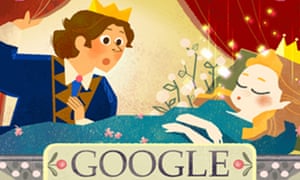Artist Sophie Diao has imagined scenes from three stories by the French author who collected fairytales such as Cinderella and Sleeping Beauty

Once upon a time, a search engine named Google decided to celebrate the 388th birthday of Charles Perrault, the French author celebrated for collecting fairytales from Cinderella to Sleeping Beauty in the 17th century.
Today’s Google’s doodle was created by the artist Sophie Diao, and shows her imagining of scenes from three of the stories Perrault collected in Les Contes de ma Mère l’Oye (Mother Goose Stories) in 1697. Cinderella is shown in her coach transformed from a pumpkin: “Being thus decked out, she got up into her coach; but her godmother, above all things, commanded her not to stay till after midnight, telling her, at the same time that if she stayed at the ball one moment longer her coach would be a pumpkin again, her horses mice, her coachman a rat, her footmen lizards, and her clothes become just as they were before,” wrote Perrault, more than 300 years ago.
And Puss in Boots is shown by Diao holding forth in front of a grumpy-looking ogre; Perrault’s version of the scene sees the cat telling the ogre: “I have been assured … that you have the gift of being able to change yourself into all sorts of creatures you have a mind to; you can, for example, transform yourself into a lion, or elephant, and the like.” The ogre is eventually persuaded to transform himself into a mouse, whereupon Puss eats him.
Perrault was born in 1628, and worked as an adviser in the French court of Louis XIV. He only began to write his fairy stories, borrowing the plots and the well-known opening, “once upon a time” or il était une fois, from folk tales, later in life.
“Perrault’s stories set the standard for the modern fairytale,” said Google. “The publication of the tales coincides with the rise of the modern novel: they came after Don Quixote and La Princesse de Clèves, but before Robinson Crusoe and Tom Jones. The backbone of these fairytales persists within contemporary novels and movies, making our reading or cinema-going a fundamentally optimistic venture: when we hear ‘once upon a time’, we’ve come to expect –and anxiously await – a ‘happily ever after’.”
Perrault’s stories also include Little Red Riding Hood and Bluebeard. In The Classic Fairy Tales, Iona and Peter Opie write that the French author’s “achievement was that he accepted the fairy tales at their own level” and “recounted them without impatience, without mockery, and without feeling they required any aggrandisement, such as a frame-story, though he did end each tale with a rhymed moralité.”
The stories he chose, writes Neil Philip in The Complete Fairy Tales of Charles Perrault, might have been old, but what he did with them was new. “Writing for a jaded audience at the sumptuous court of Louis XIV of France, he entertained them with the simple stories of the people. He gave the tales a more courtly dress and a more knowing air than they would have had in a peasant’s cottage, but he did not make fun of them or spoil them with literary embroidery. He let them speak for themselves, and in the process revealed that what they had to say was not so simple after all.”
